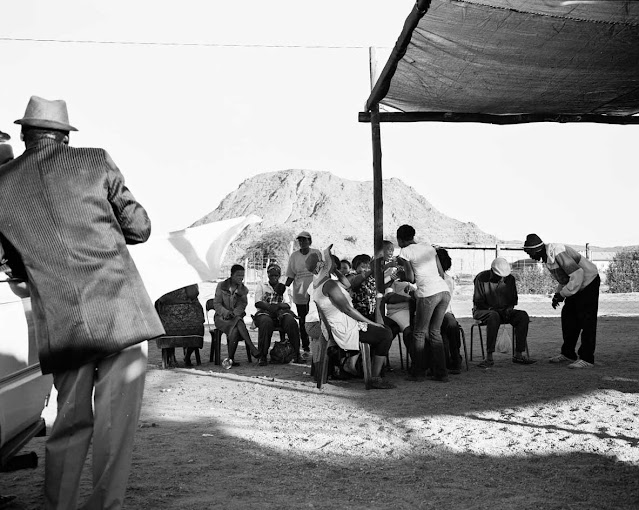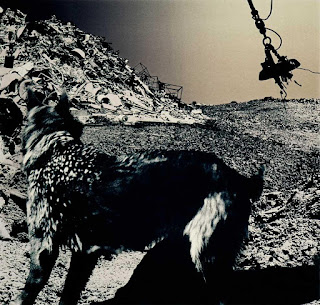 |
Photographs 1980s - now. By Jo Ractliffe.
|
Photographs by Jo Ractliffe
Steidl/The Walther Collection, Neu-Ulm and New York, 2020. 456 pp., 291 illustrations, 10¼x11¾".
It’s a bit of a presumptuous thing, to review a book that represents a lifetime of artistic work. Nevertheless, that is the task at hand: to say something that has not already been said regarding Jo Ractliffe: Photographs 1980s - now, the 468-page monograph whose publication coincides with a major retrospective of the photographer’s work at the Art Institute of Chicago, DRIVES (on view through August).
The monograph spans the full range of Ractliffe’s 35-year career, from her time at Cape Town’s prestigious Michaelis School of Fine Arts, when the anti-apartheid movement was gaining momentum, to the present day. Such retrospective compilations, particularly when published alongside an exhibition, can often read like a museum catalogue — the poor man’s version of work much better seen in person. It must be said that the exhibition is far more comprehensive in the sense that it includes video, book art and multimedia installations. The book, by its nature, focuses primarily on Ractliffe’s photographic work, although she has worked extensively in other media, such as film, book art or multimedia installations. But it is by no means a consolation prize.
What strikes me the most, when I first open the book and hear its yet-unbroken spine crunch, is the paper: a matte finish gives the work a subtle sheen. I run my hand across the page and it is bumpy, like there is a thin layer of dust — the accumulated weight of history and images. I not only see, but feel, the grain of the image, the rough ridge of each blade of grass glinting in the sun, and every pebble on a dirt road; I wonder if this is what it feels like to read in Braille. I run my fingers across a positively apocalyptic sky in Ractliffe’s Nadir series, a shiny smear of ink that looks sticky, the kind that’s fresh off the printer. I feel compelled to double-check that it’s dry: I turn my hand over, palm up, sweeping my thumb across my finger pads. It comes up empty.
All books are tactile by nature, but there is something about the printing of this particular monograph that brings out, in full force, the fine-grained texture and vivid detail of Ractliffe’s photographs. Pages are more than mere carriers for text and reproduced images; they give the work new nuance. It is like I am seeing it for the very first time.
 |
Of course, there is much more at stake than a well-developed, beautiful image. Ractliffe’s work is almost always framed by the trauma of apartheid, though the regime’s brutality and its violent clashes with the anti-apartheid movement rarely figure within the photographs. Instead, Ractliffe often drifts towards the quietly pervasive legacies of state-sanctioned violence: the debris and stray dogs in squatter camps; the innocuous farms that housed the apartheid government’s secret police; the serene grasslands that are sites of ethnic restitution disputes.
This indirect form of engagement carries into the image: things that are ostensibly the subjects of Ractcilffe’s gaze, as suggested by a photograph’s title, are infrequently the image’s actual focus. The “Woman on the footpath,” for instance, is barely visible against a vast terrain of rocky landfills at the Roque Santeira market in Angola. Readers must squint hard, “Where’s Waldo?”-style, to find her camouflaged among the trash heaps and abruptly bisected by the image’s bottom frame. It is harder still to perceive, without any context, that these are the banal traces left behind in the wake of South Africa’s Border War, a spillover of the Cold War’s little-discussed African front.
 |
Many of Ractliffe’s admirers have written eloquently on the artist’s conceptual engagement with themes of surveillance, documentary, and urban history in South Africa. But the monograph’s matte printing also reminds us that Ractliffe is deft on a purely technical level, making even the farthest horizons vibrate with a near overload of detail. It is an admittedly basic observation, but one that, I think, is crucial to understanding how Ractliffe transforms seemingly empty tracts of land into remarkably busy ones. For it is not the political framework alone that renders her landscapes visibly — and in this particular monograph, tangibly — heavy, weighed down with history’s vestiges.
And what remains? This is a question that Ractliffe, looking back upon her work, grapples with alongside the reader. Photographs 1980s - now is organized chronologically, divided into different sections that are introduced and narrated by the artist herself. She is compellingly honest in her reflections, dedicated less to making a compact narrative of her career than to musing out loud alongside the reader. “In the original exhibition handout,” Ractliffe writes of the dead roadside donkey who graces the monograph’s cover, “I wrote rather awkwardly about ‘narratives of violence’ and my desire ‘to engage the viewer’s interpretive agency more forcefully’. Looking back, it seems that what I was doing was setting up a series of enactments — an attempt perhaps to comprehend an experience that was, and remains, unfathomable to me.”
Alongside such musings, the book is also accompanied by a comprehensive selection of essays on Ractliffe’s work, written over the years by figures such as Okwui Enwezor, Penny Siopsis, Jill Bennett, and Matthew S. Witkovsky. There is also a substantial artist interview, conducted by Artur Walther, whose thorough knowledge of Ractliffe’s oeuvre engenders an insightful discussion about the artist’s process and influences. The novelist Emmanuel Iduma contributes a short story, based on Ractliffe’s images, revolving around an anonymous narrator who loosely traces the footsteps of a long-lost father across the sites where he was last seen.
 |
Between fiction and review, text and image, this retrospective monograph reminds me why, even nearly three decades after the official end of apartheid, Ractliffe’s ability to envision the subtle traces of violence remains not only compelling, but necessary. For these photographs, while taken in the apparent aftermath of wars and conflict, gesture also to the imminence of these events: the necessary cycles of history. If the past necessarily inflects the here and now, as Ractliffe’s work suggests, then future conditions must be seen in the current moment, however inarticulable they may be at present.













